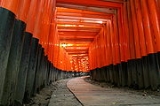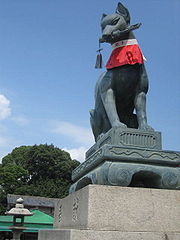
Fushimi Inari-taisha
Encyclopedia
is the head shrine of Inari, located in Fushimi-ku, Kyoto
, Japan
. The shrine sits at the base of a mountain also named Inari, and includes trails up the mountain to many smaller shrines.
Since in early Japan Inari was seen as the patron of business, each of the Torii is donated by a Japanese business. First and foremost though, Inari is the god of rice.
Merchants and manufacturers worship Inari for wealth. Donated torii
lining footpaths are part of the scenic view.
This popular shrine is said to have as many as 32,000 sub-shrines throughout Japan.
. In 965, Emperor Murakami
ordered that Imperial messengers were sent to report important events to the guardian kami of Japan. These heihaku were initially presented to 16 shrines including the Inari Shrine.
From 1871 through 1946, Fushimi Inari-taisha was officially designated one of the , meaning that it stood in the first rank of government supported shrines.
. The main shrine structure was built in 1499.
At the bottom of the hill are the and the . Behind them, in the middle of the mountain, the is reachable by a path lined with thousands of torii. To the top of the mountain are tens of thousands of for private worship.
 Foxes (kitsune
Foxes (kitsune
), regarded as the messengers, are often found in Inari shrines. One attribute is a key (for the rice granary) in their mouths.
Unlike most Shinto shrines, Fushimi Inari Taisha, in keeping with typical Inari shrines, has an open view of the main idol object (a mirror).
A drawing in Kiyoshi Nozaki's Kitsune: Japan's Fox of Mystery, Romance and Humor in 1786 depicting the shrine says that its two-story entry gate was built by Toyotomi Hideyoshi
.
The shrine draws several million worshipers over the Japanese New Year
, 2.69 million for 3 days in 2006 reported by the police, the most in western Japan.
Nara Line
Inari Station
, 10 minutes from Kyoto Station
. It is a five-minute walk from Keihan Electric Railway
Main Line Fushimi-Inari station.
s dating at least to the 19th century, and which are believed by some to be the origin of the Chinese-American
fortune cookie.
Fushimi-ku, Kyoto
is one of the eleven wards in the city of Kyoto, in Kyoto Prefecture, Japan. Famous places in Fushimi include the Fushimi Inari Shrine, with thousands of torii lining the paths up and down a mountain; Fushimi Castle, originally built by Toyotomi Hideyoshi, with its rebuilt towers and gold-lined...
, Japan
Japan
Japan is an island nation in East Asia. Located in the Pacific Ocean, it lies to the east of the Sea of Japan, China, North Korea, South Korea and Russia, stretching from the Sea of Okhotsk in the north to the East China Sea and Taiwan in the south...
. The shrine sits at the base of a mountain also named Inari, and includes trails up the mountain to many smaller shrines.
Since in early Japan Inari was seen as the patron of business, each of the Torii is donated by a Japanese business. First and foremost though, Inari is the god of rice.
Merchants and manufacturers worship Inari for wealth. Donated torii
Torii
A is a traditional Japanese gate most commonly found at the entrance of or within a Shinto shrine, where it symbolically marks the transition from the profane to the sacred...
lining footpaths are part of the scenic view.
This popular shrine is said to have as many as 32,000 sub-shrines throughout Japan.
History
The shrine became the object of Imperial patronage during the early Heian periodHeian period
The is the last division of classical Japanese history, running from 794 to 1185. The period is named after the capital city of Heian-kyō, or modern Kyōto. It is the period in Japanese history when Buddhism, Taoism and other Chinese influences were at their height...
. In 965, Emperor Murakami
Emperor Murakami
was the 62nd emperor of Japan, according to the traditional order of succession.Murakami's reign spanned the years from 946 to his death in 967.-Traditional narrative:...
ordered that Imperial messengers were sent to report important events to the guardian kami of Japan. These heihaku were initially presented to 16 shrines including the Inari Shrine.
From 1871 through 1946, Fushimi Inari-taisha was officially designated one of the , meaning that it stood in the first rank of government supported shrines.
Structures
The earliest structures were built in 711 on the Inariyama hill in southwestern Kyoto, but the shrine was re-located in 816 on the request of the monk KūkaiKukai
Kūkai , also known posthumously as , 774–835, was a Japanese monk, civil servant, scholar, poet, and artist, founder of the Shingon or "True Word" school of Buddhism. Shingon followers usually refer to him by the honorific titles of and ....
. The main shrine structure was built in 1499.
At the bottom of the hill are the and the . Behind them, in the middle of the mountain, the is reachable by a path lined with thousands of torii. To the top of the mountain are tens of thousands of for private worship.
Fox

Kitsune
is the Japanese word for fox. Foxes are a common subject of Japanese folklore; in English, kitsune refers to them in this context. Stories depict them as intelligent beings and as possessing magical abilities that increase with their age and wisdom. Foremost among these is the ability to assume...
), regarded as the messengers, are often found in Inari shrines. One attribute is a key (for the rice granary) in their mouths.
Unlike most Shinto shrines, Fushimi Inari Taisha, in keeping with typical Inari shrines, has an open view of the main idol object (a mirror).
A drawing in Kiyoshi Nozaki's Kitsune: Japan's Fox of Mystery, Romance and Humor in 1786 depicting the shrine says that its two-story entry gate was built by Toyotomi Hideyoshi
Toyotomi Hideyoshi
was a daimyo warrior, general and politician of the Sengoku period. He unified the political factions of Japan. He succeeded his former liege lord, Oda Nobunaga, and brought an end to the Sengoku period. The period of his rule is often called the Momoyama period, named after Hideyoshi's castle...
.
The shrine draws several million worshipers over the Japanese New Year
Japanese New Year
The is one of the most important annual festivals, with its own unique customs, and has been celebrated for centuries. Due to the importance of the holiday and the preparations required, the preceding days are quite busy, particularly the day before, known as Ōmisoka.The Japanese New Year has been...
, 2.69 million for 3 days in 2006 reported by the police, the most in western Japan.
Access
The shrine is a three-minute walk from JRWest Japan Railway Company
, also referred to as , is one of the Japan Railways Group companies and operates in western Honshū. It has its headquarters in Kita-ku, Osaka.-History:...
Nara Line
Nara Line
The is a commuter rail line in the Osaka-Kobe-Kyoto metropolitan area, operated by the West Japan Railway Company . Its official termini are Kizu Station in Kizugawa and Kyōto Station in Kyoto, within Kyoto Prefecture; however, all trains continue past Kizu on the Yamatoji Line to Nara Station in...
Inari Station
Inari Station
is a railway station on the Nara Line of West Japan Railway Company . It is in Fushimi-ku, Kyoto, Japan.-Layout:The station has two platforms with two tracks between them.-Near the station:...
, 10 minutes from Kyoto Station
Kyoto Station
is the most important transportation hub in Kyoto, Japan. It has Japan's second-largest train station building and is one of the country's largest buildings, incorporating a shopping mall, hotel, movie theater, Isetan department store, and several local government facilities under one 15-story roof...
. It is a five-minute walk from Keihan Electric Railway
Keihan Electric Railway
is a Japanese railway operator in Osaka, Kyoto, and Shiga Prefectures. It is known as , or .-History:Keihan started its operation between Osaka and Kyoto in 1910. It was the first electric railway to connect these two cities, and the first line on the left bank of Yodo River...
Main Line Fushimi-Inari station.
Environs
In the approach to the shrine are a number of sweet shops dating , a form of fortune cookieFortune cookie
A fortune cookie is a crisp cookie usually made from flour, sugar, vanilla, and oil with a "fortune" wrapped inside. A "fortune" is a piece of paper with words of faux wisdom or a vague prophecy...
s dating at least to the 19th century, and which are believed by some to be the origin of the Chinese-American
American Chinese cuisine
American Chinese cuisine refers to the style of food served by many Chinese restaurants in the United States. This type of cooking typically caters to Western tastes, and differs significantly from the original Chinese cuisine.-History:...
fortune cookie.
Modern pop culture
- Memoirs of a GeishaMemoirs of a Geisha (film)Memoirs of a Geisha is a 2005 film adaptation of the novel of the same name, produced by Steven Spielberg's Amblin Entertainment and Spyglass Entertainment and by Douglas Wick's Red Wagon Productions. It was directed by Rob Marshall. It was released in the United States on December 9, 2005 by...
(2005) - Aria the Natural ep. 5ARIA (manga)is a utopian science fantasy manga by Kozue Amano. The series was originally titled when it was published by Enix in the magazine Monthly Stencil, being retitled when it moved to Mag Garden's magazine Comic Blade. Aqua was serialized in Stencil from 2001 to 2002 and collected in two tankōbon volumes...
(2006)
See also
- List of Shinto shrines
- Twenty-Two Shrines
- Modern system of ranked Shinto ShrinesModern system of ranked Shinto ShrinesThe The The (sometimes called simply , was an organizational aspect of the establishment of Japanese State Shinto. This system classified Shinto shrines as either official government shrines or "other" shrines...
External links
- Official Site (ja) (NB: music plays automatically on the top web page)
- Photographs of Fushimi Inari-taisha
- English visitor information

